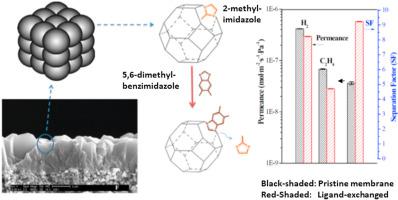当前位置:
X-MOL 学术
›
J. Membr. Sci.
›
论文详情
Our official English website, www.x-mol.net, welcomes your feedback! (Note: you will need to create a separate account there.)
Enhancing selectivity of ZIF-8 membranes by short-duration postsynthetic ligand-exchange modification
Journal of Membrane Science ( IF 9.5 ) Pub Date : 2021-02-01 , DOI: 10.1016/j.memsci.2020.118743 Lin Lang , Fateme Banihashemi , Joshua B. James , Jiansong Miao , Jerry Y.S. Lin
Journal of Membrane Science ( IF 9.5 ) Pub Date : 2021-02-01 , DOI: 10.1016/j.memsci.2020.118743 Lin Lang , Fateme Banihashemi , Joshua B. James , Jiansong Miao , Jerry Y.S. Lin

|
Abstract Post-synthesis modification of zeolitic imidazolate framework (ZIF) membranes offers new opportunities to tailor ZIF structures and improve their separation performance. This work utilizes membrane surface ligand exchange (MSLE) to replace methylimidazole (MeIM) with 5,6-dimethylbenzimidazole (DBIM) and investigates its effect on the gas separation properties of ZIF-8 membranes containing varying amounts of intercrystalline defects (perfect and imperfect membranes). Upon short time (0.5 h) MSLE modification, the pristine ZIF-8 membrane shows a significant enhancement in H2/C2H6 selectivity (12–22) and C3H6/C3H8 selectivity (150–188) with small declines in gas permeance (29.5% for H2, 6.5% for C3H6). MSLE modification also improves the separation performance of imperfect ZIF-8 membranes, but to a lesser extent (C3H6/C3H8 selectivity increasing from 37.5 to 63.3). Some of the MeIM in the ZIF-8 membrane crystals are replaced by bulkier DBIM, facilitated by the presence of the intercrystalline pores resulting in more exchange on the imperfect membrane. The short-duration ligand exchange reduces intracrystalline pore diffusivity, to a greater extent for larger molecules as compared to smaller molecules, leading to a reduction in gas permeance and an increase in separation factor. However, long-duration (5 h) MSLE modification on a perfect ZIF-8 membrane lowers the C3H6/C3H8 selectivity due to an increase in the intercrystalline transport for bulkier C3H8 with an increase in C3H6 permeance due to enhanced solubility within the modified ZIF-8 structure.
中文翻译:

通过短期合成后配体交换修饰提高 ZIF-8 膜的选择性
摘要沸石咪唑酯骨架 (ZIF) 膜的合成后改性为定制 ZIF 结构和提高其分离性能提供了新的机会。这项工作利用膜表面配体交换 (MSLE) 用 5,6-二甲基苯并咪唑 (DBIM) 代替甲基咪唑 (MeIM),并研究其对含有不同数量晶间缺陷的 ZIF-8 膜(完美膜和不完美膜)的气体分离性能的影响)。在短时间(0.5 小时)MSLE 改性后,原始 ZIF-8 膜显示出 H2/C2H6 选择性(12-22)和 C3H6/C3H8 选择性(150-188)的显着增强,气体渗透率小幅下降(29.5%) H2,C3H6 为 6.5%)。MSLE 改性还提高了不完善的 ZIF-8 膜的分离性能,但程度较小(C3H6/C3H8 选择性从 37.5 增加到 63.3)。ZIF-8 膜晶体中的一些 MeIM 被更大的 DBIM 取代,由于晶间孔的存在,导致不完美膜上的更多交换。与较小分子相比,对于较大分子而言,短期配体交换在更大程度上降低了晶内孔扩散率,从而导致气体渗透性降低和分离因子增加。然而,在完美的 ZIF-8 膜上进行长时间(5 小时)MSLE 修饰降低了 C3H6/C3H8 的选择性,这是因为体积更大的 C3H8 的晶间传输增加,而 C3H6 渗透性增加,这是由于改进的 ZIF-8 膜中的溶解度增加所致。 8 结构。ZIF-8 膜晶体中的一些 MeIM 被更大的 DBIM 取代,由于晶间孔的存在,导致不完美膜上的更多交换。与较小分子相比,对于较大分子而言,短期配体交换在更大程度上降低了晶内孔扩散率,从而导致气体渗透性降低和分离因子增加。然而,在完美的 ZIF-8 膜上进行长时间(5 小时)MSLE 修饰降低了 C3H6/C3H8 的选择性,这是因为较大的 C3H8 的晶间传输增加,而 C3H6 渗透性增加,这是由于改进的 ZIF-8 膜中的溶解度增加所致。 8 结构。ZIF-8 膜晶体中的一些 MeIM 被更大的 DBIM 取代,由于晶间孔的存在,导致不完美膜上的更多交换。与较小分子相比,对于较大分子而言,短期配体交换在更大程度上降低了晶内孔扩散率,从而导致气体渗透性降低和分离因子增加。然而,在完美的 ZIF-8 膜上进行长时间(5 小时)MSLE 修饰降低了 C3H6/C3H8 的选择性,这是因为较大的 C3H8 的晶间传输增加,而 C3H6 渗透性增加,这是由于改进的 ZIF-8 膜中的溶解度增加所致。 8 结构。与较小分子相比,对于较大分子而言,短期配体交换在更大程度上降低了晶内孔扩散率,从而导致气体渗透性降低和分离因子增加。然而,在完美的 ZIF-8 膜上进行长时间(5 小时)MSLE 修饰降低了 C3H6/C3H8 的选择性,这是因为较大的 C3H8 的晶间传输增加,而 C3H6 渗透性增加,这是由于改进的 ZIF-8 膜中的溶解度增加所致。 8 结构。与较小分子相比,对于较大分子而言,短期配体交换在更大程度上降低了晶内孔扩散率,从而导致气体渗透性降低和分离因子增加。然而,在完美的 ZIF-8 膜上进行长时间(5 小时)MSLE 修饰降低了 C3H6/C3H8 的选择性,这是因为较大的 C3H8 的晶间传输增加,而 C3H6 渗透性增加,这是由于改进的 ZIF-8 膜中的溶解度增加所致。 8 结构。
更新日期:2021-02-01
中文翻译:

通过短期合成后配体交换修饰提高 ZIF-8 膜的选择性
摘要沸石咪唑酯骨架 (ZIF) 膜的合成后改性为定制 ZIF 结构和提高其分离性能提供了新的机会。这项工作利用膜表面配体交换 (MSLE) 用 5,6-二甲基苯并咪唑 (DBIM) 代替甲基咪唑 (MeIM),并研究其对含有不同数量晶间缺陷的 ZIF-8 膜(完美膜和不完美膜)的气体分离性能的影响)。在短时间(0.5 小时)MSLE 改性后,原始 ZIF-8 膜显示出 H2/C2H6 选择性(12-22)和 C3H6/C3H8 选择性(150-188)的显着增强,气体渗透率小幅下降(29.5%) H2,C3H6 为 6.5%)。MSLE 改性还提高了不完善的 ZIF-8 膜的分离性能,但程度较小(C3H6/C3H8 选择性从 37.5 增加到 63.3)。ZIF-8 膜晶体中的一些 MeIM 被更大的 DBIM 取代,由于晶间孔的存在,导致不完美膜上的更多交换。与较小分子相比,对于较大分子而言,短期配体交换在更大程度上降低了晶内孔扩散率,从而导致气体渗透性降低和分离因子增加。然而,在完美的 ZIF-8 膜上进行长时间(5 小时)MSLE 修饰降低了 C3H6/C3H8 的选择性,这是因为体积更大的 C3H8 的晶间传输增加,而 C3H6 渗透性增加,这是由于改进的 ZIF-8 膜中的溶解度增加所致。 8 结构。ZIF-8 膜晶体中的一些 MeIM 被更大的 DBIM 取代,由于晶间孔的存在,导致不完美膜上的更多交换。与较小分子相比,对于较大分子而言,短期配体交换在更大程度上降低了晶内孔扩散率,从而导致气体渗透性降低和分离因子增加。然而,在完美的 ZIF-8 膜上进行长时间(5 小时)MSLE 修饰降低了 C3H6/C3H8 的选择性,这是因为较大的 C3H8 的晶间传输增加,而 C3H6 渗透性增加,这是由于改进的 ZIF-8 膜中的溶解度增加所致。 8 结构。ZIF-8 膜晶体中的一些 MeIM 被更大的 DBIM 取代,由于晶间孔的存在,导致不完美膜上的更多交换。与较小分子相比,对于较大分子而言,短期配体交换在更大程度上降低了晶内孔扩散率,从而导致气体渗透性降低和分离因子增加。然而,在完美的 ZIF-8 膜上进行长时间(5 小时)MSLE 修饰降低了 C3H6/C3H8 的选择性,这是因为较大的 C3H8 的晶间传输增加,而 C3H6 渗透性增加,这是由于改进的 ZIF-8 膜中的溶解度增加所致。 8 结构。与较小分子相比,对于较大分子而言,短期配体交换在更大程度上降低了晶内孔扩散率,从而导致气体渗透性降低和分离因子增加。然而,在完美的 ZIF-8 膜上进行长时间(5 小时)MSLE 修饰降低了 C3H6/C3H8 的选择性,这是因为较大的 C3H8 的晶间传输增加,而 C3H6 渗透性增加,这是由于改进的 ZIF-8 膜中的溶解度增加所致。 8 结构。与较小分子相比,对于较大分子而言,短期配体交换在更大程度上降低了晶内孔扩散率,从而导致气体渗透性降低和分离因子增加。然而,在完美的 ZIF-8 膜上进行长时间(5 小时)MSLE 修饰降低了 C3H6/C3H8 的选择性,这是因为较大的 C3H8 的晶间传输增加,而 C3H6 渗透性增加,这是由于改进的 ZIF-8 膜中的溶解度增加所致。 8 结构。



























 京公网安备 11010802027423号
京公网安备 11010802027423号